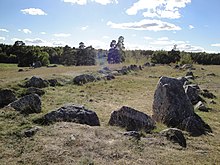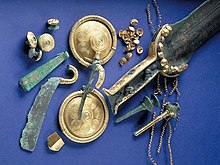Håga burial mound
The burial mound of Håga ( Swedish Hågahögen , also Kung Björns Hög or Björns Hög ) is located on the banks of the Hågaån stream near Flogsta , west of Uppsala in Uppland in Sweden . It dates from the late Bronze Age and was excavated at the beginning of the 20th century.
Because of its considerable size (about 7.0 meters high, 45.0 m diameter) it is interpreted as the grave of an important man. Split bones, whose marrow had been removed, were found in the mound, which is interpreted as evidence of cannibalism . Split human bones were also at the living space Dyrholmen the ertebølle culture found.
description
The barrow consists of turf and contains a grave complex that is strange to the area around the Mälaren and points to southern Scandinavian influences. It covered a man-high, hollowed-out oak trunk that served as a coffin. The soil had been discolored from him. The burnt bones of a man lay in the coffin. His grave goods were remarkable : a sword , the handle of which was decorated with gold strips and gold pins, a so-called "spectacle spiral" made of bronze almost entirely covered with spiral-decorated gold sheet , tweezers with gold details, thin gold spirals that may have been worn in the hair or in costume.
The buried person was cremated without any grave goods (which was usually the custom). The burned bones had been placed in the coffin and the objects added. The reason is probably that cremation was introduced as a new type of burial through influences from southern Scandinavia. Only the dead person was cremated, but not his grave goods. At a time when old customs are being replaced by new ones, it is possible that older ideas may persist in parallel. This is probably the case with the Håga burial mound. There are other special features about this tomb. At the time of the burial, the objects seem to have been made new, perhaps for burial. That shows how important it was to be buried in a certain way and how funerals were used to demonstrate power and status.
Among the people who took part in the excavation was a student named Gustav Adolf Bernadotte. At that time, Sweden's King Gustav VI was. Adolf was still Prince of Sweden and Duke of Skåne ; he was an avid archaeologist who participated in many excavations, especially in Italy. In Häga he received his first instruction in field archeology. His teacher was Oscar Almgren , professor of archeology at Uppsala University.
The hill has been called "King Bjorn's Hill" for centuries. According to popular belief, a Viking king named Björn was buried here. This king is mentioned as Björn på Högen or Björn vid Högen (Björn on the hill) in Icelandic sources, which was interpreted as Björn i Häga (Björn in Häga). The investigation revealed that the hill does not, however , date from the Viking Age (800-1050 AD). He was already around 1000 BC. BC, in the middle Bronze Age, was created. The stone setting Kung Björns kyrka lies south of the Hagahögen.
Names that refer to a king can be found on several megalithic sites ( Kung Björns Grav , Kung Rings Grav , Kung Östens Grav ), on Rösen ( Kung Tryggves grav ), rune stones Kung Kåres sten , Kung Sigges sten and on building stones ( Kung Götriks sten , Kung Anes Sten or stone pairs Kung Råds grav) and are even more common in Denmark. Large mounds with a diameter of more than 30 meters are often called Kungshögen ( German "Königshügel" ) in Sweden . They are mainly found around the Mälaren , some examples can also be found in other landscapes. The large mounds often date from the younger Iron Age . Some of the biggest: Anundshög in Västmanland , Grönehög in Bohuslän , Högom in Medelpad , Inglinge hög in Smaland , Kung Ranes hög in Vastergotland, Ledbergs kulle in Östergötland , Skalunda hög in Vastergotland , Ströbo hög in Västmanland and the three hill in Old Uppsala in Uppland.
literature
- Kent Andersson: Gold of the North. Scandinavian treasures from the Bronze Age to the Vikings . Theiss. Stuttgart 2008, ISBN 978-3-8062-2184-8
Web links
- Håga burial mound - entry in the Riksantikvarieämbetet's "Fornsök" database (Swedish)
Coordinates: 59 ° 50 ′ 12.1 ″ N , 17 ° 35 ′ 11.4 ″ E



